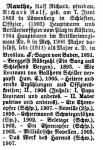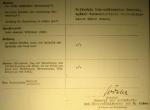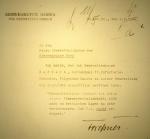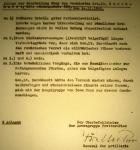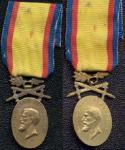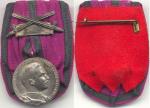-
Posts
4,908 -
Joined
-
Last visited
-
Days Won
97
Content Type
Profiles
Forums
Blogs
Gallery
Events
Store
Everything posted by Dave Danner
-
Rauthe was also an author. Here is his entry from the 1913 edition of the Lexikon der deutschen Dichter und Prosaisten vom Beginn des 19. Jahrhunderts bis zur Gegenwart, by Franz Brümmer, And here is the entry for Fußartillerie-Regiment Nr. 14 from the Bibliographie der deutschen Regiments- und Bataillons-Geschichten, by Paul Morris Hirsch (1905), showing that Rauthe authored both 1890s versions of the regiment's history:
-
I think you have him. Rauthe retired on 21 April 1911, transferring to the civil service, and last appears in the 1910 rank list. He received the KO3 on 25 May 1911. He was reactivated in World War I and promoted to Oberstleutnant z.D. on 18 June 1915. At the time, he was Kommandant of immob. Etappen-Kommandantur I Altona, so that could account for the Hamburg Hanseatenkreuz. I can't find a listing for a BMV3X, but if he got it, you could be right that the KO4 and BMV4X are replacements.
-
The Biechl in 11./b.RIR 2 was Franz Xaver Biechl. He was born on 10. Nov. 1881. Entered service 24 Oct. 1903 in 16.IR and transferred to RIR 2 on 2 August 1914 01.10.04 - Gefreiter 01.08.05 - Unteroffizier (Kapitulant) 24.04.09 - Sergeant 24.10.12 - Vizefeldwebel 07.08.14 - Feldwebel 09.09.15 - Offizier-Stellvertreter Decorations were the Prinz-Regent Luitpold-Medaille, Military Merit Cross 2nd Class with Swords, Military Merit Cross 2nd Class with Crown and Swords, Bavarian Dienstauszeichnung 1. Klasse, and Iron Cross 2nd Class. He was wounded at least once, but there appears to be water damage to the Kriegsstamrolle, and that part of the page is hard to read. Dave
-
Otto Wöhler 1894-1987 Oberst - 1.1.38 Generalmajor - 1.1.42 (RDA 1.4.41) Generalleutnant - 1.10.42 General der Infanterie - 1.6.43 Komm. Gen., I.Armeekorps - 1.4.43-14.8.43 Oberbefehlshaber, 8. Armee - 15.8.43-28.12.44 Oberbefehlshaber, Heeresgruppe Süd - 28.12.44-6.4.45 From an officer evaluation (Beurteilung):
-
Johannes Frießner 1892-1971 Oberst - 1.3.38 Generalmajor - 14.8.40 Generalleutnant - 16.10.42 General der Infanterie - 1.4.43 Generaloberst - 23.7.44 Kdr., 102. Infanterie-Division - 1.5.42-20.1.43 mit d. Führung d. XXIII. Armeekorps beauftragt - 20.1.43-1.4.43 Kdr. Gen., XXIII. Armeekorps - 1.4.43-31.1.44 mit d. Führung d. Armeegruppe Frießner beauftragt - 2.2.44-22.2.44 mit d. Führung d. Armee-Abteilung Narwa beauftragt - 23.2.44-20.4.44 Kdr., Armee-Abteilung Narwa - 20.4.44-3.7.44 Oberbefehlshaber, Heeresgruppe Nord - 3.7.44-25.7.44 Oberbefehlshaber, Heeresgruppe Südukraine - 25.7.44-23.9.44 Oberbefehlshaber, Heeresgruppe Süd - 23.9.44-23.12.44 RK: 23 July 1943 DKiG: 09 June 1943 From an endorsement to the evaluation of Generalleutnant Karl Burckhardt: From a (not very positive) evaluation of Generalleutnant Karl Burdach
-

Heer Fretter-Pico, Maximilian
Dave Danner replied to Dave Danner's topic in Germany: All Eras: Signature Database
From the annex to the evaluation of Generalleutnant Karl Burckhardt, then listed as missing in action, later confirmed captured by the Soviets. Here he includes the "-Pico". -
Busch, Ernst * 6. Juli 1885 in Essen-Steele, † 17. Juli 1945 in Aldershot, England General der Infanterie - 1.2.1938 Generaloberst - 19.7.1940 Generalfeldmarschall - 1.2.1943 Kdr. der 23. Division - 15.10.1935-4.2.1938 Komm.Gen. des VIII. Armeekorps - 4.2.1938-23.10.1939 Oberbefehlshaber der 16. Armee - 23.10.1939-4.11.1943 mit der Führung der Heeresgruppe Mitte beauftragt - 28.10.1943-6.5.1944 Oberbefehlshaber der Heeresgruppe Mitte - 6.5.1944-28.6.1944 Oberbefehlshaber Nordwest - 20.3.1945-1.5.1945 Oberbefehlshaber Nord - 1.5.1945-7.5.1945 Ritter des Ordens "Pour le Mérite" (PLM) - 8.10.1918 Ritterkreuz des Eisernen Kreuzes (RK) - 26.5.1940 Eichenlaub zum Ritterkreuz des Eisernen Kreuzes (EL) - 21.8.1943 https://de.wikipedia.org/wiki/Ernst_Busch_(Offizier) https://www.lexikon-der-wehrmacht.de/Personenregister/B/BuschE.htm Signature and photo from the Personal-Nachweis in Busch's Personalakte:
-

Heer Manstein, Erich von
Dave Danner replied to hucks216's topic in Germany: All Eras: Signature Database
-

Heer TR Bar with two Romanian medals with pics
Dave Danner replied to azyeoman's topic in Wehrmacht Medals, Decorations & Awards
Reverses of gold, silver and bronze: Also, as you may have noticed, I took pictures of these all with the same ribbon. I think all but one of my Medalii Barbatie si Credinta came without ribbons. I am pretty sure I have all six - gold, silver and bronze from both wars - but as I said, I don't have my collection at hand. -

Heer TR Bar with two Romanian medals with pics
Dave Danner replied to azyeoman's topic in Wehrmacht Medals, Decorations & Awards
Here are a bronze and gold Medalia "Bărbăţie şi Credinţă" side by side for size/suspension/font/etc/ comparison. I honestly don't remember which was which, but one is the WW1 version and one the WW2. I am several hundred miles from my collection, so I can't get better images. -
The picture below is from the Wehrmacht personnel file of char.Maj.z.V. Joachim von Baer. He was born in 1877 and served in Baden's Leib-Grenadier-Regiment Nr. 109 from 1897 to 1907. He was recalled in August 1914 and served in some Landsturm postings and as a Bahnhofskommandant (OLt.a.D. 10.9.14, Hptm.a.D. 3.11.15, char.Maj.a.D. 6.4.21 for those keeping track). He was recalled to service in January 1938 and became a char.Maj.z.V. on 15.6.38. As you can see, the file lists his awards as the EK2, the Knight 2nd Class with Swords of the Order of the Zähringen Lion, the Honor Cross for Combatants and the Hungarian WW1 Commemorative Medal. But as you can also see, his ribbon bar has 5 ribbons. I am thinking the unidentified ribbon is the 1902 Baden Regierungs-Jubiläumsmedaille, since he was an active officer in LGR 109 in 1902. Any guesses as to why it was not listed under "Auszeichnungen"? Also, it is hard to tell from the picture, but it looks like the order might be EK2-BZ3bX-FKE-UngKEM-BadRJM[?]. If this is the BadRJM, is it out of order after a foreign award? Thanks and regards
-

Austria-Hungary Sources of good Austrian awards
Dave Danner replied to dond's topic in Austro-Hungarian Empire
I also like Berts Sammlerecke. I have found some nice Austrian and German stuff through Liverpool Medals, but until and unless the GBP weakens more against the dollar, I am probably only window-shopping there (that actually applies to the Eurozone as well). -
Otto Fretter-Pico Kdr., Artillerie-Regiment 297 (6.2.1940-7.3.1942) Artillerie-Kommandeur 102 (Arko 102) (7.3.1942-20.12.1942) mit d. Führung d. 57. Infanterie-Division beauftragt (20.2.1943-1.5.1943) Kdr. Gen., 57. Infanterie-Division (1.5.1943-18.9.1943) Kdr. Gen., 148. Reserve-Division (25.9.1943-18.9.1944) Kdr. Gen., 148. Infanterie-Division (18.9.1944-28.4.1945) From his Personal-Nachweis in his Wehrmacht Personalakte:
-
Maximilian Fretter-Pico Kdr. Gen., 97. leichte Infanterie-Division (15.4.1941-27.12.1941) mit d. Führung d. XXX. Armeekorps beauftragt (27.12.1941-23.12.1942) Kdr. Gen., XXX. Armeekorps (23.12.1942-18.7.1944) Kdr. Armee-Abteilung Fretter-Pico (23.12.42-3.2.43) mit d. Führung d. 6. Armee beauftragt (18.7.1944-22.12.1944) Oberbefehlshaber, Armeegruppe Fretter-Pico (17.9.1944-23.12.1944) Kdr. Gen., Stellv. Gen.-Kdo. IX. Armeekorps u. Befehlshaber Wehrkreis IX (30.3.45-22.4.45) From his Personal-Nachweis in his Wehrmacht Personalakte: OLD IMAGE REPLACED WITH BETTER VERSION
-
No one owns the documents. They are part of the Captured German Military Records collection at the U.S. National Archives. They are official German government documents held by a U.S. government agency, and not copyright-able under U.S. or German law. The photographs of the documents, of course, are the copyright of the person who took the photo, but since that person is me, I am pretty sure that's not an issue.
-
It is nice to see some coverage of Jamaica, but to me it is a little sad that among 153 people recognized in Jamaica's 2011 National Honours and Awards ceremony on National Heroes Day, the only one who gets mentioned in the US media is the late reggae singer. I guess he's the only one the US editors thought would be recognized. There were six awards of the Order of Jamaica, 26 awards of the Order of Distinction in the grade of Commander (CD), and 26 awards of the Order of Distinction in the grade of Officer (OD). There were two awards of the Badge of Honour for Gallantry (BGH), 17 of the Badge of Honour for Meritorious Service, and 23 of the Badge of Honour for Long and Faithful Service. The BGHs were for lifesaving or attempted lifesaving. The Medal of Honour for Gallantry went to three Jamaica Defence Force soldiers, one posthumously. The Medal of Honour for Meritorious Service went to 19 Jamaica Defence Force members, 15 Jamaica Constabulary Force members, nine Island Special Constabulary Force (ISCF) members and seven Jamaica Fire Brigade members. The Medals of Honour for Gallantry were to Lance Corporal Marvin McLennon, Private Damion Brown and Private Maurice Green. Pvt. Green's was posthumous. These were for an operation against gunmen of a drug gang in the Tivoli Gardens housing project in Kingston in May 2010.
-
I think it is more likely that they were made at the same time, or that the shorter one came later. It looks like the St. Michael is an error. Someone mistakenly or incorrectly used that ribbon instead of the Oldenburg one. A (mainly) civilian St. Michael makes little sense between what appears to be the Hesse Tapferkeistmedaille and the Hamburg Hanseatenkreuz, while an Oldenburg Friedrich-August Kreuz makes more sense. The shorter ribbon bar then appears to leave off the peacetime commemorative medals (Prussian Centenary and Baden Jubilee) and keep only the decorations (the Prussian long service cross was considered a decoration). I assume the last ribbon is the Rettungsmedaille am Bande. I can't speak to whether it is fake, as you'd need better pictures of the threads and needle and need to check the ribbons. The St. Michael error could have been made by a tailor in 1935 or a faker in 1995, for all I know.
-
I should note that even though (2) is more common than (1) doesn't mean that it is common. After all, Saxe-Coburg-Gotha was not very big - it was the 15th largest German state, ranking in population after Saxe-Meiningen and just before the combined Reuß principalities. As I said above, the various grades of the Ducal Saxe Ernestine House Order were basically the Iron Cross analogs for Saxe-Coburg-Gotha. The Silver Merit Medal of the order with the swords clasp would be the grade for soldiers in the rank of Unteroffizier, Sergeant, Gefreiter and below. The golden Merit Medal went to soldiers in the rank of Feldwebel/Wachtmeister and VIzefeldwebel/Vizewachtmeister and their equivalents in the medical and Beamten ranks (Waffenmeister, Zahlmeister-Stellvertreter, Feldunterarzt, etc.) and the navy, though there were very few navy awards from this landlocked state. For Offizier-Stellvertreter and Feldwebelleutnants and their equivalents, it was the Merit Cross with Swords of the order. The Bavarian equivalent to the silver Merit Medal would be the Military Merit Crosses 3rd Class and 3rd Class with Crown. For comparison, there were about 290,000 awards of the 3rd Class with Swords and 73,000 of the 3rd Class with Crown and Swords. Adding to the rarity is that the silver Merit Medal's swords clasp was dated. They are dated with either the year awarded ("1914", "1915", etc.) or 1914 and the year awarded ("1914/5", "1914/6", etc.). I think there might be other variants - Nimmergut's catalog mentions a "1915/6". If your document is for this medal, the document should say which clasp and if it doesn't, you'd have to go by the date of the document. Regards, Dave
-
I actually have a number of examples of signatures that could be added, but they don't fit your criteria. What I have are digital photos of officer personnel files, where the officer signed and attached a photo to his Personal-Nachweis. Here, for example, is Gotthard Heinrici, which you can compare to the example you have in the databse. Please let me know if you think these would be of use.
-
There wasn't a medal with that name. There is either (1) the oval silver Herzog Carl-Eduard-Medaille which was silver and could be awarded with a swords clasp, or (2) the Saxe-Coburg version of the silberne Verdienstmedaille of the Ducal Saxe-Ernestine House Order (SEHO). Can you clarify which one by the document? Number (1) was very rare, awarded without regard to rank a total of 344 times. Number (2) was the basic Iron Cross 2nd Class equivalent of Saxe-Coburg-Gotha for junior enlisted soldiers, awarded about 9800 times. I'm not sure, but the 9800 might include the Silver SEHO medals of the other two Saxon duchies, but theirs would only be a small portion, since they awarded the Saxe-Altenburg Bravery Medal and the Saxe-Meiningen Medal for Merit in War as their basic Iron Cross 2nd Class equivalent. Here is (1): Here is (2): And
-

France Need help with page of French Naval Military book
Dave Danner replied to army historian's topic in France
The ship names look like "Ariege", "Wagram" "?" and "Cuvier". I can't find a reference for the French navy in that timeframe, but there have been a number of ships with those names over the years (except for the one I can't read). I guess the ports are Brest, Lorient and Toulon? -
My references don't have any information on military service by Johann Heinrich Friedrich (AKA John Henry Frederick). He may have joined as a Kriegsfreiwiliger and just didn't get a commission, so he doesn't show up among the various Leutnants and Leutnants der Reserve. Or he might have been a Lt.d.R.a.D. or d.L.a.D., a.D. so he's not in the 1914 Ranklist and d.R./d.L. so he doesn't show up in the ERL under recalled officers. And never promoted during the war so he doesn't show up in the MWB. As for the other Freiherren von Schröder with war service: 1. Johann Heinrich, born 15.4.1852, Fideikomissherr auf Groß-Schwansee. In the 1914 RL (p.742) as a Rittm.d.R., Gren.-Regt. zu Pferde Nr. 3, with the 1870EK2 and LD1. Promoted Maj.d.R. as Führer, le. Mag.-Fuhrpk.-Kol. 2, Korps Zastrow. Received the MMV2 and possibly the clasp to the Iron Cross 2nd Class. Uncle to John Henry Frederick. 2. Johann Heinrich George, born 24.2.1867, Landrat, Kreis Eckernförde. RAO4 and EK2w. Uncle to John Henry Frederick. 3. Johann Heinrich Alexander Adolf Moritz, born 3.2.1870, died 17.3.1918. In the 1914 RL (p.755) as a Rittm.d.R., Husaren-Regt. Nr. 7, with the LD1. Uncle to John Henry Frederick. 4. Johann Heinrich Hans, born 6.11.1887. In the 1914 RL (p.748) as a Lt.d.R., Drag.-Regt. Nr. 18 (Schleswig). Promoted OLt.d.R. while serving with the Mun.-Kol., Fußart.-Regt. Nr. 20. Received the MMV2 and the SMK. Brother to John Henry Frederick. 5. Johann Heinrich Kurt Theodor, born 24.11.1889. In the 1914 RL (p.391) as a Lt. in HR 7 and the ERL (p.433) as a Hptm.i.G. in the 10.Armee and a Rittm.a.D. According to Uwe's link in the other thread, later a Nazi Party official and SS officer. Brother to John Henry Frederick. 6. Johann Heinrich Karl Herbert, born 10.2.1894. In the ERL (p.433) as a Lt. in HR 7 and Lt.a.D. Brother to John Henry Frederick. 7. Johann Heinrich Helmuth, born 20.7.1898. In the ERL (p.434) as a Lt. in HR 7 and Lt.a.D. Brother to John Henry Frederick. 8. Rudolph Edgar, born 27.5.1884. In the 1914 RL (p.769) as a Lt.d.R. in Jäg.-Regt. zu Pferde Nr. 8 (II Hamburg), died of wounds 28.5.1916 as an OLt.d.R. in RIR 92. Distant cousin. 9. Rudolf Bruno, born 5.1.1895. Missing in action in 1915 and presumed dead. No information on rank, so probably a Kriegsfreiwilliger. Distant cousin. Regards


